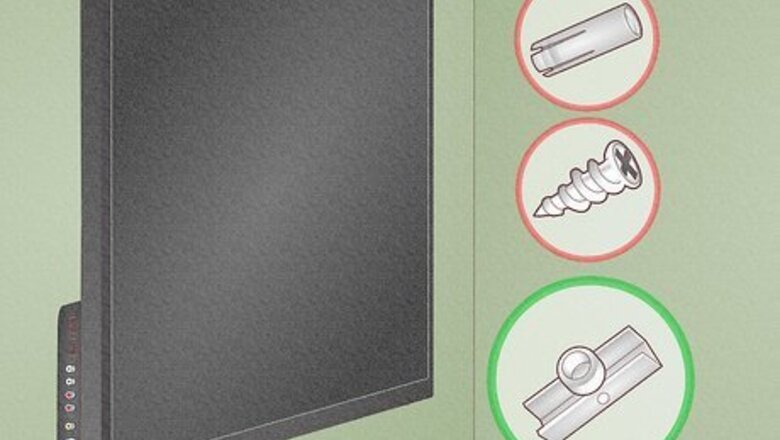
views
- Use toggle anchors or molly bolts that support your TV’s weight when mounting it without studs.
- Select a TV mount that is compatible with your TV bracket pattern and can handle the weight of your TV.
- Hang your TV on the wall without studs by securing a wall mount with toggle anchors, building your own French cleat mount, or mounting your TV on the ceiling.
Considerations Before Mounting
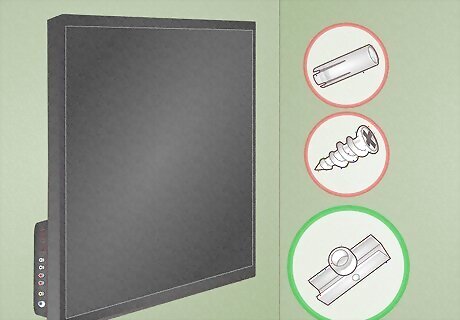
Choose anchors and bolts that support your TV’s weight. When hanging a TV on drywall, normal screws aren’t enough to support its weight. Special anchors like toggle anchors and molly bolts can support more weight, making them great to use on drywall. However, not all anchors and bolts support the same amount of weight, so select ones that can withstand your TV’s weight. Most anchors and bolts list how much weight they can carry on the packaging. Toggle anchors and bolts have metal clasps or toggles at the end that expand once they’re placed in drywall. The clasps hook onto the back of drywall, which better supports and distributes the TV’s weight on the wall. Anchors made for a lighter load can crack and rip your drywall when supporting too heavy objects. If the wall anchors are not rated for the weight of your TV, you need to cut open the wall and install solid wood blocking in between the studs so you could utilize that to screw the TV mount into it.

Choose a TV mount that’s compatible with your TV. Different TVs have different bracket patterns on the back, so search for your TV type along with “bracket” or “mount” to find the recommended mount to buy. Additionally, make sure the mount you choose can support your TV’s weight. Most mounting packages and online listings specify the weight limits that they can carry.

Use any kind of mount you want. Some TV mounts are stationary, meaning they stay firmly against the wall, while others can tilt up and down and swivel side to side. However, when mounting a TV on drywall, some argue that it's best to use a stationary mount, although that's debatable. You can buy stationary TV mounts from most retailers, or make your own from wood, called a French cleat. You can use a flat mount or you can use an articulating mount. As long as it's supported properly and installed properly, it doesn't matter which one you use. Hanging your TV from the ceiling is another popular mounting choice when wall studs aren’t available. Both swivel and fixed mounts are great to use with ceiling mounts.
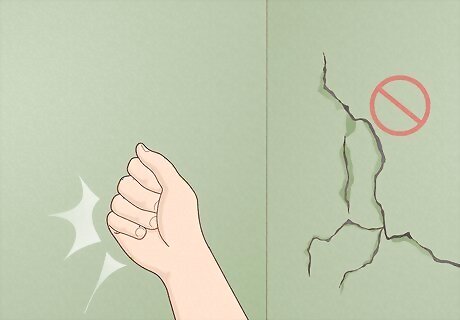
Hang your TV on a sturdy section of wall. When finding a place to hang your TV, inspect your walls for any damage. Since you won’t be using strong wall studs to hang your TV, your drywall needs to be free from any cracks, crumbles, and decay.
Mounting a TV with Toggle Anchors

Press your wall mount to the wall and mark the drill holes. To start mounting your TV, hold up your mount to the wall where you want your TV to hang. Use a level to make sure the mount is straight on the wall. Then, mark the hole positions on the mount onto the wall with a pencil.

Drill pilot holes into each mark you just made. With your power drill, attach a drill bit that matches the size of the toggle anchors that you’ll be using. The package lists the size you need to use. Then, drill a hole through the drywall at each mark you made on the wall.
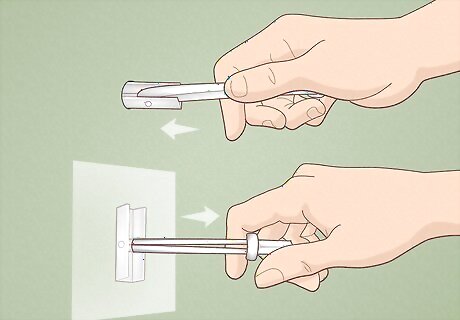
Insert the toggle anchor into the hole and pull to get the toggle to catch. Flatten the toggle bit and place it through the hole you drilled. Then, pull the plastic tab back towards you to force the toggle to expand and lay flat against the back of the drywall. You might need to jiggle or shake the tab a bit to get the toggle to expand. The metal toggle at the end of the anchor fastens to the back of your drywall. This better disperses the weight of your TV. When it is hung up, all of the drywall resists its weight instead of one fixed point.

Push the plastic anchor against the wall and snap off the tab. At the end of the plastic tab is a circular, plastic anchor. Pull the tab back to make sure the toggle is tight against the wall and push the anchor all the way to the wall. Make sure it’s as tightly fastened to the wall as possible, then snap off the tabs that are still extending from the wall. In place of toggle anchors, use molly bolts. These bolts are similar to toggle anchors, except they need a setting tool to fasten the anchor to the wall. Place the molly bolt inside the hole and hook a setting tool over the screw. Then, squeeze the handles of the tool. This pulls the screw towards you and extends the bolt’s butterfly backing, fastening it to the drywall.

Place the mount against the wall and drill screws into each anchor hole. Line your TV mount against the wall to match the holes you drilled into the wall. Lightly screw each screw that came with your toggle anchor package into the holes with your hands. This helps to hold up your mount and ensures that it’s still straight. Then, drill each screw into the wall.
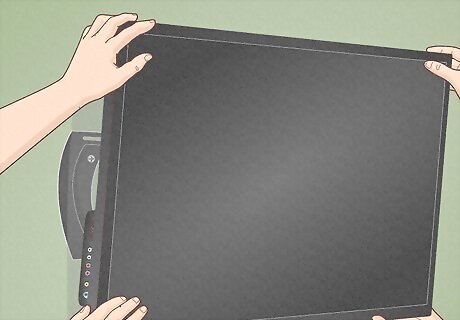
Hang your TV on the mount. With a friend or family member helping you, lift up each side of your TV. Align the bracket hooks or clips on the back of your TV to the mount, sliding the pieces into place. Carefully let go of the TV to make sure it’s securely held by the mount. If your bracket has additional screws or bolts to tighten the TV bracket to the mount, screw those in with a screwdriver after you’ve placed the TV on the mount.
Mounting with a French Cleat
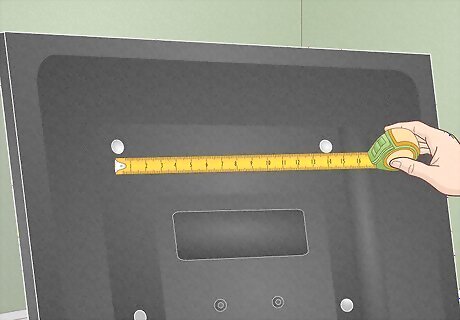
Measure the distance between the bracket holes on your TV. On the back of your TV, there should be 2 holes where mounting brackets are inserted. Use a measuring tape to find the distance between the holes and jot the number down.

Saw a 2x4 piece of wood in half at a 45° angle with a table saw. Choose a 2x4 that is a bit smaller than the length of your TV. Adjust your saw so it is at a 45° angle. Then, saw your 2x4 in half. If you don’t have a table saw, use a circular or jig saw. You will be left with 2 pieces of wood: one with the 45° angle facing up and the other facing down. These pieces interlock to create the French cleat. The piece of wood with the 45° angle facing up is drilled into your wall while the piece angled down screws into your TV.
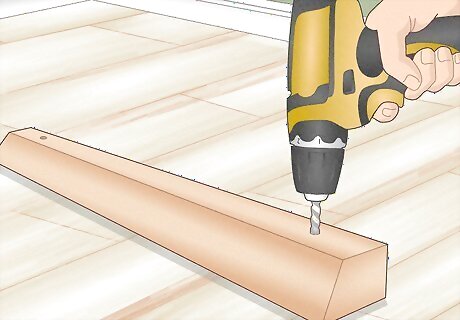
Drill a hole at both ends of the wood that has the 45° angle facing up. Use a pencil to make a mark several inches (cm) away from the end of both sides of the wood. Attach a drill bit to your drill that matches the size of the toggle anchors that you are using. Then, drill a hole through the wood at the marks you made. This piece of wood is finished, unless you want to paint it to match your wall or camouflage with your TV.
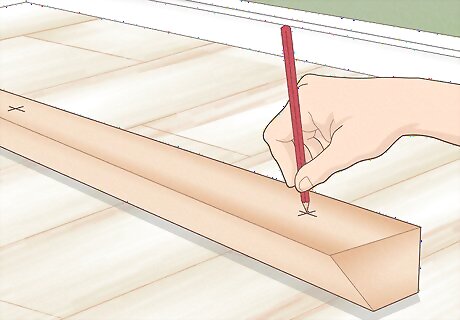
Mark the drill holes on the wood that has the 45° angle facing down. Position your piece of wood so the thicker, shorter side of the wood is facing up and the thinner, longer side is flat on your work area. Measure your piece of wood and subtract it by the distance of your TV’s bracket holes. Then, divide the difference by 2. This gives you the distance to mark a hole at on each end of the wood. For example, your piece of wood might be 40 inches (101 cm) long and the distance between the bracket holes on your TV is 30 inches (76 cm). Subtract the bracket distance from the total wood length, which is 10 inches (25 cm). Divide that by 2, which is 5 inches (12.5 cm). So, you’d make a hole mark 5 inches (12.5 cm) from each end of the wood.

Drill holes through the wood in the places you just marked. Insert a drill bit that is a little bit larger than the bracket screws recommended for your TV. With the shorter side of the wood still facing up, drill a hole through the wood at each mark you made. If you don’t know what size bracket screws to use with your TV, simply search for your TV brand and “mounting screws” or “bracket screws.”
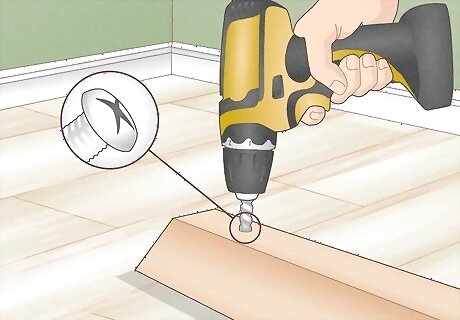
Drill countersink holes on the other side of the piece of wood. Flip your piece of wood over so the thinner, longer side is facing up. Change your drill bit to a countersink bit that is about as wide as the head of the bracket screw. Drill about ⅓ of the way through the hole so when you place the screw through it, the head fits inside and about ⅓ of the screw is visible through the other end.
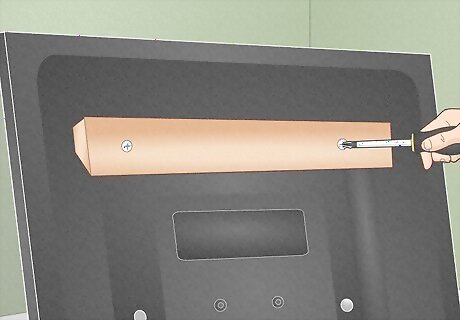
Screw the wood bracket that has the 45° angle facing down into your TV. Hold the piece of wood to the back of your TV so that the thicker, smaller side is against it and the 45° angle is facing down. Place the bracket screws into the holes and tighten them into your TV with a screwdriver.
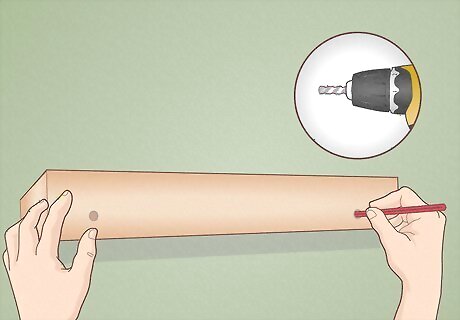
Mark the wall bracket drill holes on your wall and drill pilot holes. Hold up the wood piece up to the wall where you want the TV to hang. Simply mark the drill holes on the wall with a pencil. Then, use a drill bit that matches the size of your toggle anchors to drill a hole through the drywall at each mark.
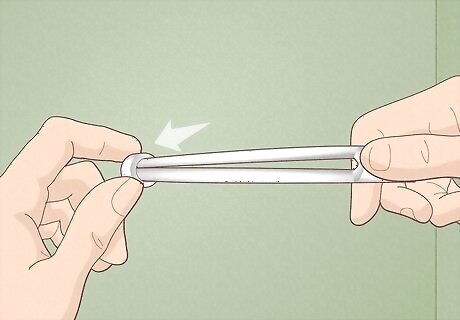
Insert toggle anchors into the hole and secure the anchor. Slide the toggle anchor into each hole, pulling or wiggling it towards you to ensure the toggle lies flush against the drywall. Then, push the plastic anchor into the wall and snap the tabs off.

Set your bracket against the wall and drill screws into each hole. Position your bracket so the thicker, shorter side is against the wall and the 45° angle is facing up. Insert the screws that came with your toggle package into the bracket holes so they barely poke out of the wood. Then, align the bracket holes with the holes you drilled into the wall. Drill one screw into the anchor hole. Use a level to make sure the bracket is straight, then drill in the other screw.

Hang your TV on the bracket. Get a friend or family member’s help and lift up each side of your TV. Simply fit the down facing bracket on your TV into the upwards facing bracket on the wall. You might need to slide your TV over so that both pieces of wood are in line with each other.
Mounting from the Ceiling
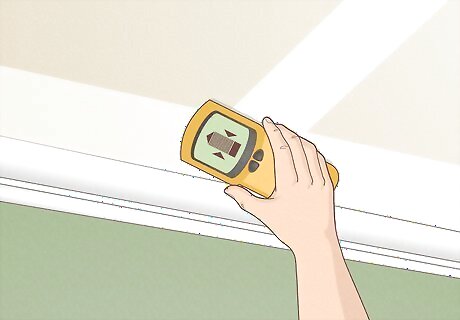
Use a stud finder to find a beam where you want your TV to hang. Set up a ladder in the area that you want to mount your TV. Climb the ladder and rest your stud finder against the ceiling. Simply pass it back and forth across your ceiling. When it beeps, you’ve hit a stud, so mark the area with a pencil. Make sure to find 2 studs that you can drill the mount into.

Hold the ceiling mount to the ceiling and mark the drill holes. Place the mount against the ceiling, aligning the drill holes with the studs you just marked. Then, outline the drill holes with a pencil.

Drill pilot holes into the drill marks you made. Attach the recommended drill bit size for the screws that came with your ceiling mount kit. Then, drill holes into the marks you made on the ceiling.
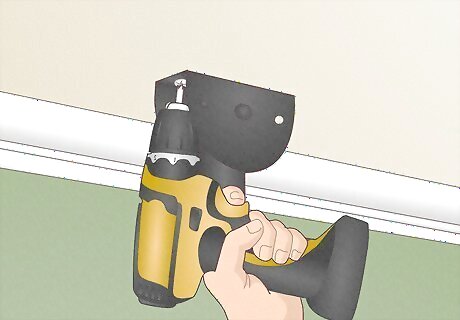
Place the mount against the ceiling and fasten it with the screws. With your drill, secure your mount to the ceiling by drilling the screws into the holes you made. If your kit uses bolts, you will tighten them to the ceiling with a socket wrench.

Attach the mounting extension to the ceiling mount. As all ceiling mounts are different, follow the directions that come with your kit. This usually involves fastening the extension to the mount with screws and a screwdriver.
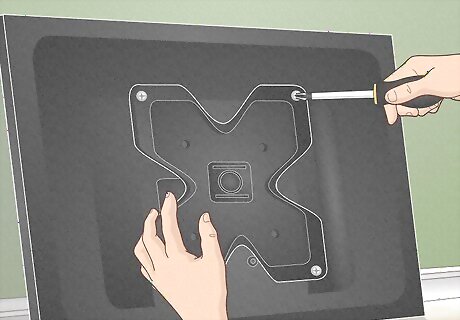
Fasten the mounting bracket to the back of your TV. Your kit also comes with a bracket that you place on your TV, which attaches to the ceiling mount extension. Follow your kit’s instructions, tightening the bracket onto the back of your TV with the screws and bolts provided.

Attach your TV bracket to the ceiling extension. With a friend or family member helping you, carefully lift up your TV to meet the ceiling extension piece. Follow your kit’s directions to fasten the bracket to the extension, which typically requires screwing and tightening a fastener to the bracket and extension.















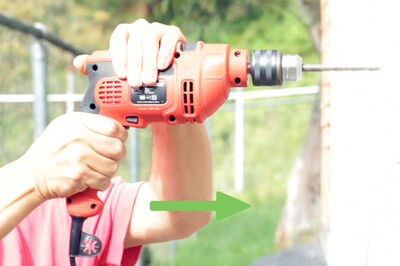

Comments
0 comment